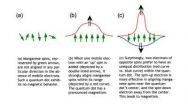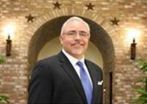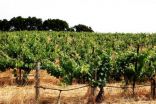(Press-News.org) BUFFALO, N.Y. -- At the smallest scales, magnetism may not work quite the way scientists expected, according to a recent paper in Physical Review Letters by Rafał Oszwałdowski and Igor Žutić of the University at Buffalo and Andre Petukhov of the South Dakota School of Mines and Technology.
The three physicists have proposed that it would be possible to create a quantum dot -- a kind of nanoparticle -- that is magnetic under surprising circumstances.
Magnetism is determined by a property all electrons possess: spin. Individual spins are akin to tiny bar magnets, which have north and south poles. Electrons can have an "up" or "down" spin, and a material is magnetic when most of its electrons have the same spin.
Mobile electrons can act as "magnetic messengers," using their own spin to align the spins of nearby atoms. If two mobile electrons with opposite spins are in an area, conventional wisdom says that their influences should cancel out, leaving a material without magnetic properties.
But the UB-South Dakota team has proposed that at very small scales, magnetism may be more nuanced than that. It is possible, the physicists say, to observe a peculiar form of magnetism in quantum dots whose mobile electrons have opposing spins.
In their Physical Review Letters article (http://www.buffalo.edu/news/pdf/June11/Paper1.pdf), the researchers describe a theoretical scenario involving a quantum dot that contains two free-floating, mobile electrons with opposite spins, along with manganese atoms fixed at precise locations within the quantum dot.
The quantum dot's mobile electrons act as "magnetic messengers," using their own spins to align the spins of nearby manganese atoms.
Under these circumstances, conventional thinking would predict a stalemate: Each mobile electron exerts an equal influence over spins of manganese atoms, so neither is able to "win."
Through complex calculations, however, Oszwałdowski, Žutić and Petukhov show that the quantum dot's two mobile electrons will actually influence the manganese spins differently.
That's because while one mobile electron prefers to stay in the middle of the quantum dot, the other prefers to locate further toward the edges. As a result, manganese atoms in different parts of the quantum dot receive different messages about which way to align their spins.
In the "tug-of-war" that ensues, the mobile electron that interacts more intensely with the manganese atoms "wins," aligning more spins and causing the quantum dot, as a whole, to be magnetic. (For a visual representation of this tug-of-war, see Figure 1.)
This prediction, if proven, could "completely alter the basic notions that we have about magnetic interactions," Žutić says.
"When you have two mobile electrons with opposite spins, the assumption is that there is a nice balance of up and down spins, and therefore, there is no magnetic message, or nothing that could be sent to align nearby manganese spins," he says. "But what we are saying is that it is actually a tug of war. The building blocks of magnetism are still mysterious and hold many surprises."
Scientists including UB Professor Athos Petrou, UB College of Arts and Sciences Dean Bruce McCombe and UB Vice President for Research Alexander Cartwright have demonstrated experimentally that in a quantum dot with just one mobile electron, the mobile electron will act as a magnetic messenger, robustly aligning the spins of adjacent manganese atoms (http://www.buffalo.edu/news/pdf/June11/Paper2.pdf).
Now, Petrou and his collaborators are interested in taking their research a step further and testing the tug-of-war prediction for two-electron quantum dots, Žutić says.
Žutić adds that learning more about magnetism is important as society continues to find novel uses for magnets, which could advance technologies including lasers, medical imaging devices and, importantly, computers.
He explains the promise of magnet- or spin-based computing technology -- called "spintronics" -- by contrasting it with conventional electronics. Modern, electronic gadgets record and read data as a blueprint of ones and zeros that are represented, in circuits, by the presence or absence of electrons. Processing information requires moving electrons, which consumes energy and produces heat.
Spintronic gadgets, in contrast, store and process data by exploiting electrons' "up" and "down" spins, which can stand for the ones and zeros devices read. Future energy-saving improvements in data processing could include devices that process information by "flipping" spin instead of shuttling electrons around.
Studying how magnetism works on a small scale is particularly important, Žutić says, because "we would like to pack more information into less space."
And, of course, unraveling the mysteries of magnetism is satisfying for other, simpler reasons.
"Magnets have been fascinating people for thousands of years," Žutić says. "Some of this fascination was not always related to how you can make a better compass or a better computer hard drive. It was just peculiar that you have materials that attract one another, and you wanted to know why."
INFORMATION:
The University at Buffalo is a premier research-intensive public university, a flagship institution in the State University of New York system and its largest and most comprehensive campus. UB's more than 28,000 students pursue their academic interests through more than 300 undergraduate, graduate and professional degree programs. Founded in 1846, the University at Buffalo is a member of the Association of American Universities.
At small scales, tug-of-war between electrons can lead to magnetism
2011-06-30
ELSE PRESS RELEASES FROM THIS DATE:
Four Attorneys from Albany-Area Law Firm Selected for New York Super Lawyers List
2011-06-30
Four attorneys from Hacker Murphy, LLP, in Latham, NY, have been selected for inclusion in 2011 New York Super Lawyers. The four attorneys are James E. Hacker, David R. Murphy, John F. Harwick and Mark R. Sonders.
The Super Lawyers selections are based on an annual process in given jurisdictions. Only five percent of the lawyers in each jurisdiction are typically selected.
Three of the four Hacker Murphy attorneys selected this year for the New York Super Lawyers list have been selected before. James E. Hacker was selected from 2006 to 2009. David R. Murphy and Mark ...
Immigration Law Review Article Written by Houston Attorney Benny Agosto Jr. Has Appeared In Several Publications
2011-06-30
Houston personal injury attorney Benny Agosto Jr. of Abraham, Watkins, Nichols, Sorrels, Agosto & Friend is receiving nationwide recognition once again.
While attorney Benny Agosto is often recognized for his dedication to the Houston community and the legal profession, this time he is being singled out for his work on the widely published immigration article "But Your Honor, He's an Illegal! Can the Undocumented Worker's Alien Status Be Introduced at Trial?"
Co-authored with Texas Southern University Law Prof. Lupe Salinas and Texas attorney Eloisa ...
New therapy for childhood neuroblastoma proves feasible and safe
2011-06-30
Reston, Va. (June 29, 2011) – A new treatment option may soon be available for children with neuroblastoma according to research published in the July issue of The Journal of Nuclear Medicine. The study tested the principle that combined positron emission tomography and X-ray computed tomography (PET/CT) may be used to select children with primary refractory or relapsed high-risk neuroblastoma for treatment with a molecular radiotherapy known as 177Lu-DOTATATE. This therapeutic option was found to be viable option for children with neuroblastomas.
Neuroblastoma is a ...
Shortening time between CPR and shocks improves cardiac-arrest survival
2011-06-30
DALLAS – June 29, 2011 – Reducing the intervals between giving cardiopulmonary resuscitation (CPR) and an electronic defibrillator shock after cardiac arrest significantly improves survival, according to UT Southwestern Medical Center emergency medicine doctors involved in an international study.
Chest compressions applied within 10 seconds before the defibrillator shocks and within 20 seconds after the shock boosted survival chances by more than half compared to the rates for people who received chest compressions more than 20 seconds before or 40 seconds after the shock, ...
UBC researchers invent new drug delivery device to treat diabetes-related vision loss
2011-06-30
A team of engineers and scientists at the University of British Columbia has developed a device that can be implanted behind the eye for controlled and on-demand release of drugs to treat retinal damage caused by diabetes.
Diabetic retinopathy is the leading cause of vision loss among patients with diabetes. The disease is caused by the unwanted growth of capillary cells in the retina, which in its advanced stages can result in blindness.
The novel drug delivery mechanism is detailed in the current issue of Lab on a Chip, a multidisciplinary journal on innovative microfluidic ...
Columbia SC Hotel Offers Convenient Lodging to Students Attending Freshman Orientation at the University of South Carolina
2011-06-30
The newly opened Hilton Garden Inn Hotel in Columbia SC (Northeast) offers convenient lodging to students and their parents who will be attending freshman orientation at the University of South Carolina. There are just a few days left for students to pre-register to attend an orientation session. The one day sessions are held weekdays through July 7. Orientation will provide students with key information that will help them make a successful transition into the university. Students will be able to meet with academic advisors, register for fall classes, visit residence halls, ...
Global warming could alter the US premium wine industry in 30 years, says Stanford study
2011-06-30
Higher temperatures could significantly impact California and other premium winegrowing regions of the United States in the next 30 years, according to a new study led by Stanford University climate scientists.
Writing in the June 30 edition of Environmental Research Letters, the scientists
report that by 2040, the amount of land suitable for cultivating premium wine grapes in high-value areas of northern California could shrink by 50 percent because of global warming. However, some cooler parts of Oregon and Washington State could see an increase in premium grape-growing ...
Scottsboro Hotel Offers Close Lodging to Guests Celebrating 4th of July at Goose Pond Colony
2011-06-30
Hampton Inn & Suites Hotel Scottsboro offers nearby lodging to travelers celebrating 4th of July at Goose Pond Colony Amphitheater. This 28th annual event will begin at 6:00pm featuring The Bert David Newton Band and Cheezee Band. The National Anthem will be sung at 9:00pm by Daniel Smith, followed by fireworks. The concert will continue after the fireworks show. Admission is free; foods and drinks will be available for purchase.
Goose Pond Colony is a municipally owned resort located on the banks of the Tennessee River at Lake Guntersville, Alabama's largest lake. ...
IASLC welcomes publication of CT screening results from National Lung Screening Trial
2011-06-30
The International Association for the Study of Lung Cancer (IASLC) today welcomed the publication of positive results of the National Lung Screening Trial (NLST).
The NLST study, published today in the New England Journal of Medicine, showed that lung cancer deaths fell by 20% and all-cause mortality fell by 7% when heavy smokers were screened regularly using low-dose spiral computed tomography (CT) compared with standard chest x-ray. The NLST study followed more than 53,000 current and former smokers ages 55-74.
"Lung cancer is the leading cause of cancer death in ...
CT scans unleash a breakthrough in catching early stage lung cancer
2011-06-30
CHICAGO— The National Lung Screening Trial (NLST) is the first scientific study that provides clear evidence that CT screening significantly reduces the death rate due to lung cancer. NLST data shows 20 percent fewer lung cancer deaths among trial participants who had the CT scan compared with the chest x-ray. Until now, no screening test for lung cancer has proven effective in detecting tumors at an early, more treatable stage.
Northwestern Memorial Hospital is the only NLST site in Chicago. During the study period, more than 400 individuals enrolled in the trial locally. ...



